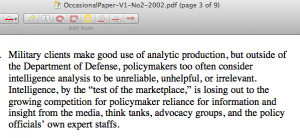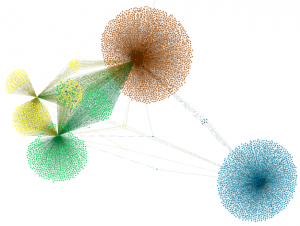Neal Rauhauser: On Intelligence & Foreign Policy Analysis — Looking Forward, Looking Behind
Advanced Cyber/IO, Ethics, Government
Looking Forward, Looking Behind
The Democratic Study Group was a 150 staff member legislative service organization(LSO) that had as customers all of the Democratic members of Congress and a good number of Republicans. This internal think tank analyzed policy proposals, serving as an in-house ‘brain’ for Congress. The “Republican Revolution” of 1994 would lead to the defunding of this entity in 1995, functionally turning over control of domestic policy making to the likes of the Heritage Foundation and the American Enterprise Institute. This has result, in my opinion, in an unmitigated policy making disaster that has ended the American empire and that endangers the stability of our nation. The construction of Progressive Congress News was a halting attempt to reverse this trend.

Our intelligence community was more resilient, due to their structure and duties. The outing of Valerie Plame, a twenty year CIA veteran and the head of our counter-proliferation operation, for failure to support the Bush administration’s desire for an adventure in Iraq, ought to have resulted in the prosecution of Dick Cheney and Karl Rove. Instead we limp forward with this crime unpunished, lugging a variety of other attendant baggage of our decay.
Having seen the problems at the domestic level and having a good idea of how they’ll be resolved, I decided I would turn my attention to foreign policy issues. I have gone through the Quadrennial Diplomacy & Development Review, the State Department’s companion to the Defense Department’s Quadrennial Defense Review, I spent the first three months of the year surveying the foreign policy discussion space, and I have my own short list of openings in the area.
Neal Rauhauser: DataScienceCentral, LinkedIn, Wrong Tool
Crowd-Sourcing, P2P / Panarchy
DataScienceCentral Users – No Klout Via LinkedIn
The retrieval of 11,712 DataScienceCentral profiles completed earlier today. I found about 2,600 instances of ‘linkedin’ when I checked the extract dt/dd files. I rigged up a bunch of awk statements and distilled that down to about 900 DSC userids and the associated plain text LinkedIn userids. I skipped the ones with embedded slashes, figuring I could go back later, and then I hit the roadblock you see above.
When we left off last night we had about 55,000 keywords from about 11,500 Data Science Central profiles. I manually reviewed and filtered, tossing out stuff that I felt was noise. Here are those nodes after I left the ForceAtlas2 layout algorithm work while I was making breakfast.
Automated community detection in Gephi found eleven communities using the default values. If you’re a puzzled Maltego user trying to follow along, community detection is an algorithm that examines edges and assigns nodes to groups, which can then be colored. This is what you are doing manually with the five colored stars Maltego lets you use to group entities.
Neal Rauhauser: Plowing Up Astroturf (Outing Robo-Tweeters)
Advanced Cyber/IO, Crowd-Sourcing
I received an interesting bit of commission work earlier today – would I help someone plow up a bunch of astroturf. It sounded like an interesting test of my expanding social network analysis skills, so I agreed to take on the task.
I was given a list of six Twitter accounts. One had 2,000+ friends, two had 1,000+ friends, one had 500+ friends, and then there were two very small accounts that were suspected to be coordinators or handlers. Numbers like that are clearly beyond the query limits for Maltego, so the solution would have to be Gephi. I recently published my savetwit shell script, which exercises the python twitter package in order to collect as much information as possible on Twitter accounts. The process kicks out a couple of csv format files suitable for use as edge files in Gephi.
The accounts in question proved to have 4,300 friends and 5,200 links. This is labeled ‘anonymous’, it isn’t anything to do with Anonymous, it’s just a group that I don’t want to spook by mentioning their names.
. . . . . .

And here we have it – the tricolor battleground, with yellow/green on one side, and red on the other. The single red and two blue dots are what modularity shows us. I suspect that if these accounts were isolated, entered into Maltego, and manually colored for allegiance that this would be a three way tussle, and that the names in this portion of the graph are the ones that are lobbing verbal grenades at each other on a nightly basis.
Neal Rauhauser: Isolating Current Conversations in E-Relations
Crowd-Sourcing
Yesterday after I posted Exploring e-International Relations I kept digging. I visited the LinkedIn profiles I had and found half a dozen additional people by using the “also viewed” column on the right. One of them responded to my request to connect, so I should be able to see the whole group fairly soon.
Having had such poor luck yesterday with an automatic method I went at it in manual mode – I looked through the followers of a few of the smaller accounts and I noticed a ‘team members’ list on the @e_IR role account. This put me in a position to see what they’re up to:
First, I loaded the e-IR-Twitter file into Maltego. This file contains both e-IR people and their close associates, so I selected just the staff by picking the entities tagged with a yellow star, one of five available ‘colors’ that can be used to tag groups of entities. Once I had the right group selected I pulled all of their tweets, and then all of the associated hashtags. The clusters around the edges are a Twitter account, it’s tweets, and then a more sparse sprinkle of hashtags.
Neal Rauhauser: From Boston to Texas: Suspicous Fertilizer Explosion
Offbeat Fun
MEDIA Catches Up:
As many as 15 dead, 160 wounded in Texas fertilizer plant blast
“It was like a nuclear bomb went off,” Muska said. “Big old mushroom cloud.”
West, Texas Fertilizer Explosion Explained
I posted Massive Fertilizer Explosion In West, Texas around 10:21 local time for the plant. That was a rush job, this is going to be a little more organized, and more technically sound.
First, West Texas does not have a fertilizer plant, they have a fertilizer storage facility. This is a small town farmer's cooperative. I'm from Iowa, this looks funny to me – very large fertilizer tank, but two small grain bins? It's like this because this location is close to grain export facilities near the mouth of the Mississippi.

Read full post with overhead imagery and other graphics.
See Also:


